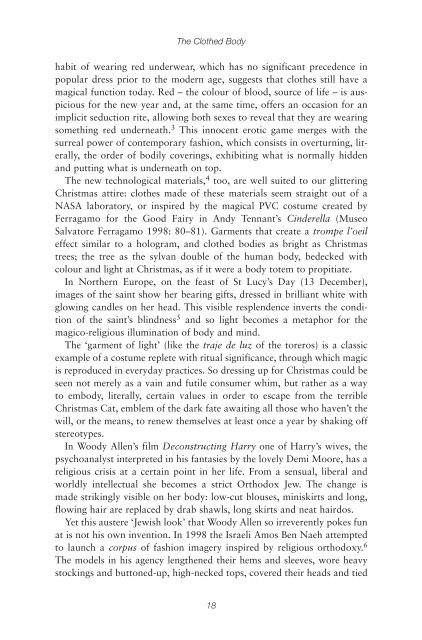You also want an ePaper? Increase the reach of your titles
YUMPU automatically turns print PDFs into web optimized ePapers that Google loves.
<strong>The</strong> <strong>Clothed</strong> <strong>Body</strong><br />
habit of wearing red underwear, which has no significant precedence in<br />
popular dress prior to the modern age, suggests that clothes still have a<br />
magical function today. Red – the colour of blood, source of life – is auspicious<br />
for the new year and, at the same time, offers an occasion for an<br />
implicit seduction rite, allowing both sexes to reveal that they are wearing<br />
something red underneath. 3 This innocent erotic game merges with the<br />
surreal power of contemporary fashion, which consists in overturning, literally,<br />
the order of bodily coverings, exhibiting what is normally hidden<br />
and putting what is underneath on top.<br />
<strong>The</strong> new technological materials, 4 too, are well suited to our glittering<br />
Christmas attire: clothes made of these materials seem straight out of a<br />
NASA laboratory, or inspired by the magical PVC costume created by<br />
Ferragamo for the Good Fairy in Andy Tennant’s Cinderella (Museo<br />
Salvatore Ferragamo 1998: 80–81). Garments that create a trompe l’oeil<br />
effect similar to a hologram, and clothed bodies as bright as Christmas<br />
trees; the tree as the sylvan double of the human body, bedecked with<br />
colour and light at Christmas, as if it were a body totem to propitiate.<br />
In Northern Europe, on the feast of St Lucy’s Day (13 December),<br />
images of the saint show her bearing gifts, dressed in brilliant white with<br />
glowing candles on her head. This visible resplendence inverts the condition<br />
of the saint’s blindness 5 and so light becomes a metaphor for the<br />
magico-religious illumination of body and mind.<br />
<strong>The</strong> ‘garment of light’ (like the traje de luz of the toreros) is a classic<br />
example of a costume replete with ritual significance, through which magic<br />
is reproduced in everyday practices. So dressing up for Christmas could be<br />
seen not merely as a vain and futile consumer whim, but rather as a way<br />
to embody, literally, certain values in order to escape from the terrible<br />
Christmas Cat, emblem of the dark fate awaiting all those who haven’t the<br />
will, or the means, to renew themselves at least once a year by shaking off<br />
stereotypes.<br />
In Woody Allen’s film Deconstructing Harry one of Harry’s wives, the<br />
psychoanalyst interpreted in his fantasies by the lovely Demi Moore, has a<br />
religious crisis at a certain point in her life. From a sensual, liberal and<br />
worldly intellectual she becomes a strict Orthodox Jew. <strong>The</strong> change is<br />
made strikingly visible on her body: low-cut blouses, miniskirts and long,<br />
flowing hair are replaced by drab shawls, long skirts and neat hairdos.<br />
Yet this austere ‘Jewish look’ that Woody Allen so irreverently pokes fun<br />
at is not his own invention. In 1998 the Israeli Amos Ben Naeh attempted<br />
to launch a corpus of fashion imagery inspired by religious orthodoxy. 6<br />
<strong>The</strong> models in his agency lengthened their hems and sleeves, wore heavy<br />
stockings and buttoned-up, high-necked tops, covered their heads and tied<br />
18

















